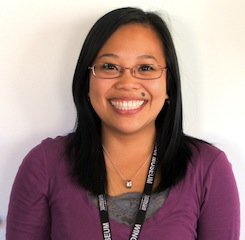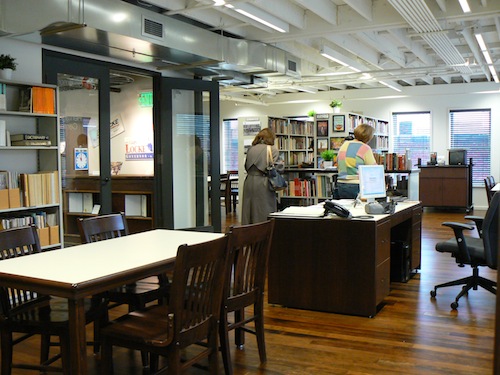By: JJ Aviado
We have two ways in which we provide the community with access to our collection: through our exhibits and library. However, let me start by explaining our Museum. Here is a great description of what the Museum is all about, taken from our website (www.wingluke.org):
“The Wing Luke Museum of the Asian Pacific American Experience is dedicated to immersing people in uniquely-American stories of survival, success, struggle, conflict, compassion and hope. The Museum is in the heart of Seattle’s vibrant Chinatown-International District, and includes the very hotel where countless immigrants first found a home, a meal and refuge. As our nation’s only museum devoted to the Asian Pacific American experience, it’s one of the few places that can truly give you a new perspective on what it means to be American. The Wing is a Smithsonian Affiliate, a partnership with the Smithsonian Institution.”
Our mission is to connect everyone to the rich history, dynamic cultures and art of Asian Pacific Americans through vivid storytelling and inspiring experiences. We follow this mission to plan the exhibits and programs, and to determine what goes into our collection. A majority of our collection has been donated by the community. Our policies for donating are that the item must follow the mission, and that it has a story.
Our exhibits are important to include because many members of the community connect with our collections through The Wing’s unique process of creating exhibits. Our Museum displays three permanent and four semi-permanent exhibits that tell the stories of the hardships, the history, and the experiences of the Asian Pacific American (APA) community locally and nationally.
Instead of having a curator on staff, we have a Collections Manager and three Exhibit Developers. The Collections Manager oversees the Museum’s collection and helps build the exhibits. The Exhibit Developers research the exhibits, help plan the exhibits, and meet with the Community Advisory Committee (CAC) members. The CAC are community members that have a connection to the exhibit and decide the exhibit’s message, how the exhibit is displayed, the exhibit’s educational aspect, and what the community programs will be.
For example, our current exhibit, From Fields to Family, focuses on food from different Asian cultures, the local politics that surround food, and how APAs have been involved from the growing to the making of food. For this exhibit, we invited people who were food critics, restaurant owners, and publishers of cookbooks that had ties to APA food.
The items that are included in the exhibit are either from the Museum’s collection or are loaned from the CAC. The Exhibit Developers go through the collection to see which items are connected to the exhibit. They then gather those items and show them to the CAC, who decide which items will go into the exhibit. However, the majority of the time, we loan the items from the CAC. For our exhibit about Hmong history and culture, we had no Hmong items in our collection, so we had to borrow items from the community. On the other hand, in From Fields to Family, we had hundreds of objects in our collection. In that case, the CAC voted on which items would be in the exhibit.
The CACs are one way in which the community can have access to our collection. However, as I mentioned before, not all CACs view the items we have in the collection. A benefit, though, of loaning items from the community is that eventually they donate their items to the collection.
The Governor Gary Locke Library and Community Heritage Center is our hub of how we let people access our collection. The Library houses books, articles, periodicals, and media on culture, art, and history of the Asian countries and APAs. Patrons can visit the library for free without paying Museum admission.
The Library is also a gateway into our archives, which houses photographs, oral histories, primary documents, and artifacts. We provide a computer with access to our catalog, which contains records on a majority of the collection’s items. Patrons are able to search the catalog for any items they are looking for. Some of the records have pictures and/or descriptions of the item. The catalog is also accessible online (db.wingluke.org). In addition, 80% of our photographs are digitized and visible online.
Most of our patrons are researchers, students, teachers, and authors. Anyone is free to use the resources, and people sometimes find out about the Museum through a Google search, which list items from our collection. Most of the people who request resources are from the area, but we’ve gotten a few from out of state and even internationally.
Currently, there is no program in place for people to learn more about the items in our collection. In order to view or handle an item, a person has to make an appointment. However, we’re continually improving and adding to those records to help make it easier for people to learn more about the items and their history.
We have over 10,000 items in our collection, and we try in our own way to make them accessible to everyone. Our exhibits are a way to display what we have to not only the patrons that visit the Museum but also to the CAC members who plan the exhibits. We have a library that’s a resource center for anyone to use. We have a catalog that contains the information about the items in our collection and is accessible online. In the future, we hope to have a Study Center program in place, and possibly have other ways in which we feature items in our collection. We have a lot of great items with amazing stories, and it would be great for people to learn more about them.
 JJ Aviado is the Librarian and Community Programs Coordinator at the Wing Luke Museum of the Asian Pacific American Experience. She has a Masters in Information and Library Studies, and has been with The Wing since 2008.
JJ Aviado is the Librarian and Community Programs Coordinator at the Wing Luke Museum of the Asian Pacific American Experience. She has a Masters in Information and Library Studies, and has been with The Wing since 2008.










Add new comment